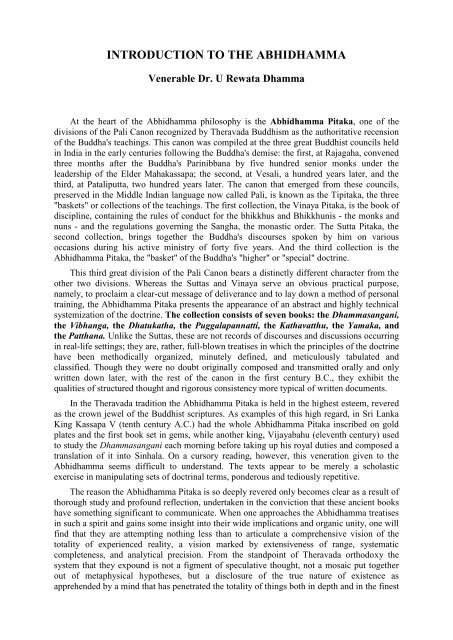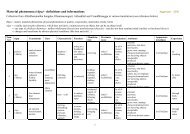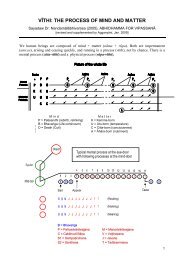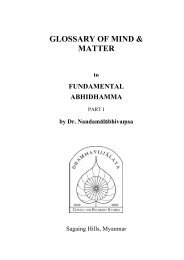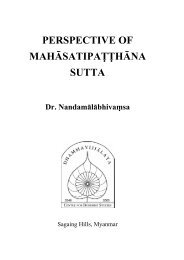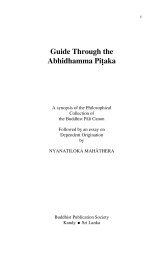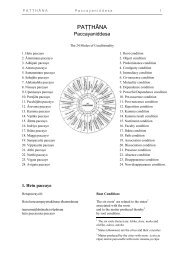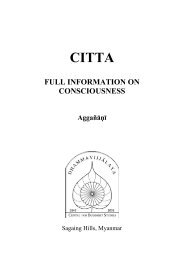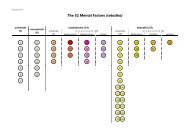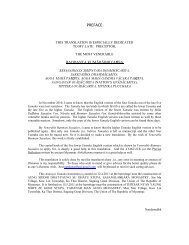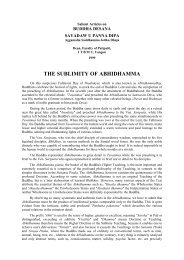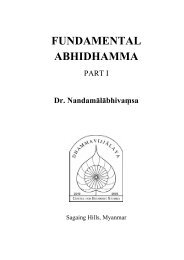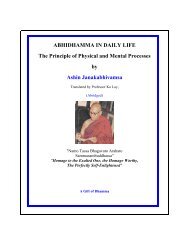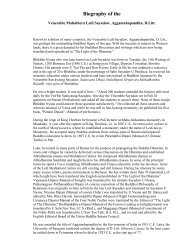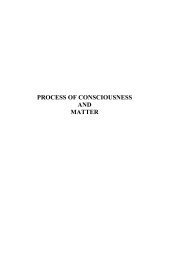INTRODUCTION TO THE ABHIDHAMMA - Abhidhamma.com
INTRODUCTION TO THE ABHIDHAMMA - Abhidhamma.com
INTRODUCTION TO THE ABHIDHAMMA - Abhidhamma.com
You also want an ePaper? Increase the reach of your titles
YUMPU automatically turns print PDFs into web optimized ePapers that Google loves.
<strong>INTRODUCTION</strong> <strong>TO</strong> <strong>THE</strong> <strong>ABHIDHAMMA</strong><br />
Venerable Dr. U Rewata Dhamma<br />
At the heart of the <strong>Abhidhamma</strong> philosophy is the <strong>Abhidhamma</strong> Pitaka, one of the<br />
divisions of the Pali Canon recognized by Theravada Buddhism as the authoritative recension<br />
of the Buddha's teachings. This canon was <strong>com</strong>piled at the three great Buddhist councils held<br />
in India in the early centuries following the Buddha's demise: the first, at Rajagaha, convened<br />
three months after the Buddha's Parinibbana by five hundred senior monks under the<br />
leadership of the Elder Mahakassapa; the second, at Vesali, a hundred years later, and the<br />
third, at Pataliputta, two hundred years later. The canon that emerged from these councils,<br />
preserved in the Middle Indian language now called Pali, is known as the Tipitaka, the three<br />
"baskets" or collections of the teachings. The first collection, the Vinaya Pitaka, is the book of<br />
discipline, containing the rules of conduct for the bhikkhus and Bhikkhunis - the monks and<br />
nuns - and the regulations governing the Sangha, the monastic order. The Sutta Pitaka, the<br />
second collection, brings together the Buddha's discourses spoken by him on various<br />
occasions during his active ministry of forty five years. And the third collection is the<br />
<strong>Abhidhamma</strong> Pitaka, the "basket" of the Buddha's "higher" or "special" doctrine.<br />
This third great division of the Pali Canon bears a distinctly different character from the<br />
other two divisions. Whereas the Suttas and Vinaya serve an obvious practical purpose,<br />
namely, to proclaim a clear-cut message of deliverance and to lay down a method of personal<br />
training, the <strong>Abhidhamma</strong> Pitaka presents the appearance of an abstract and highly technical<br />
systemization of the doctrine. The collection consists of seven books: the Dhammasangani,<br />
the Vibhanga, the Dhatukatha, the Puggalapannatti, the Kathavatthu, the Yamaka, and<br />
the Patthana. Unlike the Suttas, these are not records of discourses and discussions occurring<br />
in real-life settings; they are, rather, full-blown treatises in which the principles of the doctrine<br />
have been methodically organized, minutely defined, and meticulously tabulated and<br />
classified. Though they were no doubt originally <strong>com</strong>posed and transmitted orally and only<br />
written down later, with the rest of the canon in the first century B.C., they exhibit the<br />
qualities of structured thought and rigorous consistency more typical of written documents.<br />
In the Theravada tradition the <strong>Abhidhamma</strong> Pitaka is held in the highest esteem, revered<br />
as the crown jewel of the Buddhist scriptures. As examples of this high regard, in Sri Lanka<br />
King Kassapa V (tenth century A.C.) had the whole <strong>Abhidhamma</strong> Pitaka inscribed on gold<br />
plates and the first book set in gems, while another king, Vijayabahu (eleventh century) used<br />
to study the Dhammasangani each morning before taking up his royal duties and <strong>com</strong>posed a<br />
translation of it into Sinhala. On a cursory reading, however, this veneration given to the<br />
<strong>Abhidhamma</strong> seems difficult to understand. The texts appear to be merely a scholastic<br />
exercise in manipulating sets of doctrinal terms, ponderous and tediously repetitive.<br />
The reason the <strong>Abhidhamma</strong> Pitaka is so deeply revered only be<strong>com</strong>es clear as a result of<br />
thorough study and profound reflection, undertaken in the conviction that these ancient books<br />
have something significant to <strong>com</strong>municate. When one approaches the <strong>Abhidhamma</strong> treatises<br />
in such a spirit and gains some insight into their wide implications and organic unity, one will<br />
find that they are attempting nothing less than to articulate a <strong>com</strong>prehensive vision of the<br />
totality of experienced reality, a vision marked by extensiveness of range, systematic<br />
<strong>com</strong>pleteness, and analytical precision. From the standpoint of Theravada orthodoxy the<br />
system that they expound is not a figment of speculative thought, not a mosaic put together<br />
out of metaphysical hypotheses, but a disclosure of the true nature of existence as<br />
apprehended by a mind that has penetrated the totality of things both in depth and in the finest
detail. Because it bears this character, the Theravada tradition regards the <strong>Abhidhamma</strong> as the<br />
most perfect expression possible of the Buddha's unimpeded omniscient knowledge<br />
(sabbannuta-nana). It is his statement of the way things appear to the mind of a Fully<br />
Enlightened One, ordered in accordance with the two poles of his teaching: suffering and the<br />
cessation of suffering.<br />
The system that the <strong>Abhidhamma</strong> Pitaka articulates is simultaneously a philosophy, a<br />
psychology, and an ethics, all integrated into the framework of a program for liberation. The<br />
<strong>Abhidhamma</strong> may be described as a philosophy because it proposes an ontology, a<br />
perspective on the nature of the real. This perspective has been designated the "dhamma<br />
theory" (dhammavada). Briefly, the dhamma theory maintains that ultimate reality consists of<br />
a multiplicity of elementary constituents called dhammas, The dhammas are not noumena<br />
hidden behind phenomena, not "things in themselves" as opposed to "mere appearances, but<br />
the fundamental <strong>com</strong>ponents of actuality. The dhammas fall into two broad classes: the<br />
unconditioned dhamma, which is solely Nibbana, and the conditioned dhammas, which are<br />
the momentary mental and material phenomena that constitute the process of experience. The<br />
familiar world of substantial objects and enduring persons is, according to the dhamma<br />
theory, a conceptual construct fashioned by the mind out of the raw data provided by the<br />
dhammas. The entities of our everyday frame of reference possess merely a consensual reality<br />
derivative upon the foundational stratum of the dhammas. It is the dhammas alone that<br />
possess ultimate reality: determinate existence "from their own side" (sarupato) independent<br />
of the mind's conceptual processing of the data.<br />
Such a conception of the nature of the real seems to be already implicit in the Sutta<br />
Pitaka, particularly in the Buddha's disquisitions on the aggregates, sense bases, elements,<br />
dependent arising, etc., but it remains there tacitly in the background as the underpinning to<br />
the more pragmatically formulated teachings of the Suttas. Even in the <strong>Abhidhamma</strong> Pitaka<br />
itself the dhamma theory is not yet expressed as an explicit philosophical tenet; this <strong>com</strong>es<br />
only later, in the Commentaries. Nevertheless, though as yet implicit, the theory still <strong>com</strong>es<br />
into focus in its role as the regulating principle behind the <strong>Abhidhamma</strong>'s more evident task,<br />
the project of systemization.<br />
This project starts from the premise that to attain the wisdom that knows things "as they<br />
really are," a sharp wedge must be driven between those types of entities that possess<br />
ontological ultimacy, that is, the dhammas, and those types of entities that exist only as<br />
conceptual constructs but are mistakenly grasped as ultimately real. Proceeding from this<br />
distinction, the <strong>Abhidhamma</strong> posits a fixed number of dhammas as the building blocks of<br />
actuality, most of which are drawn from the Suttas. It then sets out to define all the doctrinal<br />
terms used in the Suttas in ways that reveal their identity with the ontological ultimates<br />
recognized by the system. On the basis of these definitions, it exhaustively classifies the<br />
dhammas into a net of pre-determined categories and modes of relatedness which highlight<br />
their place within the system's structure. And since the system is held to be a true reflection of<br />
actuality, this means that the classification pinpoints the place of each dhamma within the<br />
overall structure of actuality.<br />
The <strong>Abhidhamma</strong>'s attempt to <strong>com</strong>prehend the nature of reality, contrary to that of<br />
classical science in the West, does not proceed from the standpoint of a neutral observer<br />
looking outwards towards the external world. The primary concern of the <strong>Abhidhamma</strong> is to<br />
understand the nature of experience, and thus the reality on which it focuses is conscious<br />
reality, the world as given in experience, <strong>com</strong>prising both knowledge and the known in the<br />
widest sense. For this reason the philosophical enterprise of the <strong>Abhidhamma</strong> shades off into<br />
a phenomenological psychology. To facilitate the understanding of experienced reality, the<br />
<strong>Abhidhamma</strong> embarks upon an elaborate analysis of the mind as it presents itself to<br />
introspective meditation. It classifies consciousness into a variety of types, specifies the<br />
factors and functions of each type, correlates them with their objects and physiological bases,
and shows how the different types of consciousness link up with each other and with material<br />
phenomena to constitute the ongoing process of experience.<br />
This analysis of mind is not motivated by theoretical curiosity but by the overriding<br />
practical aim of the Buddha's teaching, the attainment of deliverance from suffering. Since the<br />
Buddha traces suffering to our tainted attitudes - a mental orientation rooted in greed, hatred,<br />
and delusion - the <strong>Abhidhamma</strong>'s phenomenological psychology also takes on the character of<br />
a psychological ethics, understanding the term "ethics" not in the narrow sense of a code of<br />
morality but as a <strong>com</strong>plete guide to noble living and mental purification. Accordingly we find<br />
that the <strong>Abhidhamma</strong> distinguishes states of mind principally on the basis of ethical criteria:<br />
the wholesome and the unwholesome, the beautiful factors and the defilements. Its<br />
schematization of consciousness follows a hierarchical plan that corresponds to the successive<br />
stages of purity to which the Buddhist disciple attains by practice of the Buddha's path. This<br />
plan traces the refinement of the mind through the progression of meditative absorptions, the<br />
fine-material-sphere and immaterial-sphere jhanas, then through the stages of insight and the<br />
wisdom of the supramundane paths and fruits. Finally, it shows the whole scale of ethical<br />
development to culminate in the perfection of purity attained with the mind's irreversible<br />
emancipation from all defilements.<br />
All three dimensions of the <strong>Abhidhamma</strong> - the philosophical, the psychological, and the<br />
ethical - derive their final justification from the cornerstone of the Buddha's teaching, the<br />
program of liberation announced by the Four Noble Truths. The ontological survey of<br />
dhammas stems from the Buddha's injunction that the noble truth of suffering, identified with<br />
the world of conditioned phenomena as a whole, must be fully understood (parinneyya). The<br />
prominence of mental defilements and requisites of enlightenment in its schemes of<br />
categories, indicative of its psychological and ethical concerns, connects the <strong>Abhidhamma</strong> to<br />
the second and fourth noble truths, the origin of suffering and the way leading to its end. And<br />
the entire taxonomy of dhammas elaborated by the system reaches its consummation in the<br />
"unconditioned element" (asankhata dhatu), which is Nibbana, the third noble truth, that of<br />
the cessation of suffering.<br />
The Twofold Method<br />
The great Buddhist <strong>com</strong>mentator, Acariya Buddhaghosa, explains the word<br />
"<strong>Abhidhamma</strong>" as meaning "that which exceeds and is distinguished from the Dhamma"<br />
(dhammdtireka-dhammavisesa), the prefix abhi having the sense of preponderance and<br />
distinction, and dhamma here signifying the teaching of the Sutta Pitaka.' When the<br />
<strong>Abhidhamma</strong> is said to surpass the teaching of the Suttas, this is not intended to suggest that<br />
the Suttanta teaching is defective in any degree or that the <strong>Abhidhamma</strong> proclaims some new<br />
revelation of esoteric doctrine unknown to the Suttas. Both the Suttas and the <strong>Abhidhamma</strong><br />
are grounded upon the Buddha's unique doctrine of the Four Noble Truths, and all the<br />
principles essential to the attainment of enlightenment are already expounded in the Sutta<br />
Pitaka. The difference between the two in no way concerns fundamentals but is, rather, partly<br />
a matter of scope and partly a matter of method.<br />
As to scope, the <strong>Abhidhamma</strong> offers a thoroughness and <strong>com</strong>pleteness of treatment that<br />
cannot be found in the Sutta Pitaka. Acariya Buddhaghosa explains that in the Suttas such<br />
doctrinal categories as the five aggregates, the twelve sense bases, the eighteen elements, and<br />
so forth, are classified only partly, while in the <strong>Abhidhamma</strong> Pitaka they are classified fully<br />
according to different schemes of classification, some <strong>com</strong>mon to the Suttas, others unique to<br />
the <strong>Abhidhamma</strong>. Thus the <strong>Abhidhamma</strong> has a scope and an intricacy of detail that set it apart<br />
from the Sutta Pitaka.<br />
The other major area of difference concerns method. The discourses contained in the<br />
Sutta Pitaka were expounded by the Buddha under diverse circumstances to listeners with
very different capacities for <strong>com</strong>prehension. They are primarily pedagogical in intent, set<br />
forth in the way that will be most effective in guiding the listener in the practice of the<br />
teaching and in arriving at a penetration of its truth. To achieve this end the Buddha freely<br />
employs the didactic means required to make the doctrine intelligible to his listeners. He uses<br />
simile and metaphor he exhorts, advises, and inspires; he sizes up the inclinations and<br />
aptitudes of his audience and adjusts the presentation of the teaching so that it will awaken a<br />
positive response. For this reason the Suttanta method of teaching is described as pariyayadbammadesana,<br />
the figurative or embellished discourse on the Dhamma.<br />
In contrast to the Suttas, the <strong>Abhidhamma</strong> Pitaka is intended to divulge as starkly and<br />
directly as possible the totalistic system that underlies the Suttanta expositions and upon<br />
which the individual discourses draw. The <strong>Abhidhamma</strong> takes no account of the personal<br />
inclinations and cognitive capacities of the listeners; it makes no concessions to particular<br />
pragmatic requirements. It reveals the architectonics of actuality in an abstract, formalistic<br />
manner utterly devoid of literary embellishments and pedagogical expedients. Thus the<br />
<strong>Abhidhamma</strong> method is described as the nippariyaya-dbammadesana, the literal or<br />
unembellished discourse on the Dhamma.<br />
This difference in technique between the two methods also influences their respective<br />
terminologies. In the Suttas the Buddha regularly makes use of conventional language<br />
(voharavacana) and accepts conventional truth (sammutisacca),truth expressed in terms of<br />
entities that do not possess ontological ultimacy but can still be legitimately referred to them.<br />
Thus in the Suttas the Buddha speaks of "I" and "you," of "man" and "woman," of living<br />
beings, persons, and even self as though they were concrete realities. The <strong>Abhidhamma</strong><br />
method of exposition, however, rigorously restricts itself to terms that are valid from the<br />
standpoint of ultimate truth (paramatthasacca): dhammas, their characteristics, their<br />
functions, and their relations. Thus in the <strong>Abhidhamma</strong> all such conceptual entities<br />
provisionally accepted in the Suttas for purposes of meaningful <strong>com</strong>munication are resolved<br />
into their ontological ultimates, into bare mental and material phenomena that are<br />
impermanent, conditioned, and dependently arisen, empty of any abiding self or substance.<br />
But a qualification is necessary. When a distinction is drawn between the two methods,<br />
this should be understood to be based on what is most characteristic of each Pitaka and should<br />
not be interpreted as an absolute dichotomy. To some degree the two methods overlap and<br />
interpenetrate. Thus in the Sutta Pitaka we find discourses that employ the strictly<br />
philosophical terminology of aggregates, sense bases, elements, etc., and thus <strong>com</strong>e within the<br />
bounds of the <strong>Abhidhamma</strong> method. Again, within the <strong>Abhidhamma</strong> Pitaka we find sections,<br />
even a whole book (the Puggalapannatti), that depart from the rigorous manner of expression<br />
and employ conventional terminology, thus <strong>com</strong>ing within the range of the Suttanta method.<br />
Distinctive Features of the <strong>Abhidhamma</strong><br />
Apart from its strict adherence to the philosophical method of exposition, the<br />
<strong>Abhidhamma</strong> makes a number of other noteworthy contributions integral to its task of<br />
systemization. One is the employment, in the main books of the <strong>Abhidhamma</strong> Pitaka, of a<br />
matika - a matrix or schedule of categories - as the blueprint for the entire edifice. This<br />
matrix, which <strong>com</strong>es at the very beginning of the Dhammasangani as a preface to the<br />
<strong>Abhidhamma</strong> Pitaka proper, consists of 122 modes of classification special to the<br />
<strong>Abhidhamma</strong> method. Of these, twenty - two are triads (tika), sets of three terms into which<br />
the fundamental dhammas are to be distributed; the remaining hundred are dyads (duka), sets<br />
of two terms used as a basis for classification. The matrix serves as a kind of grid for sorting<br />
out the <strong>com</strong>plex manifold of experience in accordance with principles determined by the<br />
purposes of the Dhamma. For example, the triads include such sets as states that are<br />
wholesome, unwholesome, indeterminate; states associated with pleasant feeling, painful<br />
feeling, neutral feeling; states that are kamma results, productive of kamma results, neither;
and so forth. The dyads include such sets as states that are roots, not roots; states con<strong>com</strong>itant<br />
with roots, not so con<strong>com</strong>itant; states that are conditioned, unconditioned; states that are<br />
mundane, supramundane; and so forth. By means of its selection of categories, the matrix<br />
embraces the totality of phenomena, illuminating it from a variety of angles philosophical,<br />
psychological, and ethical in nature.<br />
A second distinguishing feature of the <strong>Abhidhamma</strong> is the dissection of the apparently<br />
continuous stream of consciousness into a succession of discrete evanescent cognitive events<br />
called cittas, each a <strong>com</strong>plex unity involving consciousness itself, as the basic awareness of<br />
an object, and a constellation of mental factors (cetasika) exercising more specialized tasks in<br />
the act of cognition. Such a view of consciousness, at least in outline, can readily be derived<br />
from the Sutta Pitaka's analysis of experience into the five aggregates, among which the four<br />
mental aggregates are always inseparably conjoined, but the conception remains there merely<br />
suggestive. In the <strong>Abhidhamma</strong> Pitaka the suggestion is not simply picked up, but is<br />
expanded into an extraordinarily detailed and coherent picture of the functioning of<br />
consciousness both in its microscopic immediacy and in its extended continuity from life to<br />
life.<br />
A third contribution arises from the urge to establish order among the welter of technical<br />
terms making up the currency of Buddhist discourse. In defining each of the dhammas, the<br />
<strong>Abhidhamma</strong> texts collate long lists of synonyms drawn mostly from the Suttas. This method<br />
of definition shows how a single dhamma may enter under different names into different sets<br />
of categories. For example, among the defilements, the mental factor of greed (lobha) may be<br />
found as the taint of sensual desire, the taint of (attachment to) existence, the bodily knot of<br />
covetousness, clinging to sensual pleasures, the hindrance of sensual desire, etc.; among the<br />
requisites of enlightenment, the mental factor of wisdom (panna) may be found as the faculty<br />
and power of wisdom, the enlightenment factor of investigation of states, the path factor of<br />
right view, etc. In establishing these correspondences, the <strong>Abhidhamma</strong> helps to exhibit the<br />
interconnections between doctrinal terms that might not be apparent from the Suttas<br />
themselves. In the process it also provides a precision-made tool for interpreting the Buddha's<br />
discourses.<br />
The <strong>Abhidhamma</strong> conception of consciousness further results in a new primary scheme<br />
for classifying the ultimate constituents of existence, a scheme which eventually, in the later<br />
<strong>Abhidhamma</strong> literature, takes precedence over the schemes inherited from the Suttas such as<br />
the aggregates, sense bases, and elements. In the <strong>Abhidhamma</strong> Pitaka the latter categories still<br />
loom large, but the view of mind as consisting of momentary concurrences of consciousness<br />
and its con<strong>com</strong>itants leads to a fourfold method of classification more congenial to the<br />
system. This is the division of actuality into the four ultimate realities (paramattha):<br />
consciousness, mental factors, material phenomena, and Nibbana (citta, cetasika, rupa,<br />
nibbana), the first three <strong>com</strong>prising conditioned reality and the last the unconditioned<br />
element.<br />
The last novel feature of the <strong>Abhidhamma</strong> method to be noted here - contributed by the<br />
final book of the Pitaka, the Patthana - is a set of twenty-four conditional relations laid down<br />
for the purpose of showing how the ultimate realities are welded into orderly processes. This<br />
scheme of conditions supplies the necessary <strong>com</strong>plement to the analytical approach that<br />
dominates the earlier books of the <strong>Abhidhamma</strong>. The method of analysis proceeds by<br />
dissecting apparent wholes into their <strong>com</strong>ponent parts, thereby exposing their voidness of any<br />
indivisible core that might qualify as self or substance. The synthetic method plots the<br />
conditional relations of the bare phenomena obtained by analysis to show that they are not<br />
isolated self-contained units but nodes in a vast multi-layered web of inter-related, interdependent<br />
events. Taken in conjunction, the analytical method of the earlier treatises of the<br />
<strong>Abhidhamma</strong> Pitaka and the synthetic method of the Patthana establish the essential unity of<br />
the twin philosophical principles of Buddhism, non-self or egolessness (anatta) and dependent
arising or conditionality (paticca samuppdda). Thus the foundation of the <strong>Abhidhamma</strong><br />
methodology remains in perfect harmony with the insights that lie at the heart of the entire<br />
Dhamma.<br />
The Origins of the <strong>Abhidhamma</strong><br />
Although modern critical scholarship attempts to explain the formation of the<br />
<strong>Abhidhamma</strong> by a gradual evolutionary process, Theravada orthodoxy assigns its genesis to<br />
the Buddha himself. According to the Great Commentary (maha-atthakatha) quoted by<br />
Acariya Buddhaghosa, "What is known as <strong>Abhidhamma</strong> is not the province nor the sphere of<br />
a disciple; it is the province, the sphere of the Buddhas." The <strong>com</strong>mentarial tradition holds,<br />
moreover, that it was not merely the spirit of the <strong>Abhidhamma</strong>, but the letter as well, that was<br />
already realized and expounded by the Buddha during his lifetime.<br />
The Atthasalini relates that in the fourth week after the Enlightenment, while the Blessed<br />
One was still dwelling in the vicinity of the Bodhi Tree, he sat in a jewel house (ratanaghara)<br />
in the northwest direction. This jewel house was not literally a house made of precious stones,<br />
but was the place where he contemplated the seven books of the <strong>Abhidhamma</strong> Pitaka. He<br />
contemplated their contents in turn, beginning with the Dhammasangani, but while<br />
investigating the first six books his body did not emit rays. However, upon <strong>com</strong>ing to the<br />
Patthana, when "he began to contemplate the twenty-four universal conditional relations of<br />
root, object, and so on, his omniscience certainly found its opportunity therein. For as the<br />
great fish Timiratipingala finds room only in the great ocean 84,000 yojanas in depth, so his<br />
omniscience truly finds room only in the Great Book. Rays of six colours - indigo, golden,<br />
red, white, tawny, and dazzling - issued from the Teacher's body, as he was contemplating the<br />
subtle and abstruse Dhamma by his omniscience which had found such opportunity."<br />
Theravada orthodoxy thus maintains that the <strong>Abhidhamma</strong> Pitaka is authentic Word of<br />
the Buddha, in this respect differing from an early rival school, the Sarvastivadins. This<br />
school also had an <strong>Abhidhamma</strong> Pitaka consisting of seven books, considerably different in<br />
detail from the Theravada treatises. According to the Sarvastivadins, the books of the<br />
<strong>Abhidhamma</strong> Pitaka were <strong>com</strong>posed by Buddhist disciples, several being attributed to authors<br />
who appeared generations after the Buddha. The Theravada school, however, holds that the<br />
Blessed One himself expounded the books of the <strong>Abhidhamma</strong>, except for the detailed<br />
refutation of deviant views in the Katadvatthu, which was the work of the Elder Moggaliputta<br />
Tissa during the reign of Emperor Asoka.<br />
The Pali Commentaries, apparently drawing upon an old oral tradition, maintain that the<br />
Buddha expounded the <strong>Abhidhamma</strong>, not in the human world to his human disciples, but to<br />
the assembly of devas or gods in the Tavatimsa heaven. According to this tradition, just prior<br />
to his seventh annual rains retreat the Blessed One ascended to the Tavatimsa heaven and<br />
there, seated on the Pandukambala stone at the foot of the Paricchattaka tree, for the three<br />
months of the rains he taught the <strong>Abhidhamma</strong> to the devas who had assembled from the ten<br />
thousand world-systems. He made the chief recipient of the teaching his mother, Mahamayadevi,<br />
who had been reborn as a deva. The reason the Buddha taught the <strong>Abhidhamma</strong> in the<br />
deva world rather than in the human realm, it is said, is because in order to give a <strong>com</strong>plete<br />
picture of the <strong>Abhidhamma</strong> it has to be expounded from the beginning to the end to the same<br />
audience in a single session. Since the full exposition of the <strong>Abhidhamma</strong> requires three<br />
months, only devas and Brahmas could receive it in unbroken continuity, for they alone are<br />
capable of remaining in one posture for such a length of time.<br />
However, each day, to sustain his body, the Buddha would descend to the human world<br />
to go on almsround in the northern region of Uttarakuru. After collecting almsfood he went to<br />
the shore of Anotatta Lake to partake of his meal. The Elder Sariputta, the General of the<br />
Dhamma, would meet the Buddha there and receive a synopsis of the teaching given that day
in the deva world: "Then to him the Teacher gave the method, saying, 'Sariputta, so much<br />
doctrine has been shown.' Thus the giving of the method was to the chief disciple, who was<br />
endowed with analytical knowledge, as though the Buddha stood on the edge of the shore and<br />
pointed out the ocean with his open hand. To the Elder also the doctrine taught by the Blessed<br />
One in hundreds and thousands of methods became very clear."<br />
Having learnt the Dhamma taught him by the Blessed One, Sariputta in turn taught it to<br />
his own circle of 500 pupils, and thus the textual recension of the <strong>Abhidhamma</strong> Pitaka was<br />
established. To the Venerable Sariputta is ascribed the textual order of the <strong>Abhidhamma</strong><br />
treatises as well as the numerical series in the Patthana. Perhaps we should see in these<br />
admissions of the Atthasalini an implicit acknowledgment that while the philosophical vision<br />
of the <strong>Abhidhamma</strong> and its basic architecture originate from the Buddha, the actual working<br />
out of the details, and perhaps even the prototypes of the texts themselves, are to be ascribed<br />
to the illustrious Chief Disciple and his entourage of students. In other early Buddhist schools,<br />
too, the <strong>Abhidhamma</strong> is closely connected with the Venerable Sariputta, who in some<br />
traditions is regarded as the literal author of <strong>Abhidhamma</strong> treatises.<br />
The Seven Books<br />
A brief outline of the contents of the seven canonical <strong>Abhidhamma</strong> books will provide<br />
some insight into the plethora of textual material to be condensed and summarized by the<br />
<strong>Abhidhamma</strong>ttha Sangaha. The first book, the Dhammasangani, is the fountainhead of the<br />
entire system. The title may be translated "Enumeration of Phenomena," and the work does in<br />
fact undertake to <strong>com</strong>pile an exhaustive catalogue of the ultimate constituents of existence.<br />
Opening with the ,matika, the schedule of categories which serves as the framework for<br />
the whole <strong>Abhidhamma</strong>, the text proper is divided into four chapters. The first, "States of<br />
Consciousness," takes up about half of the book and unfolds as an analysis of the first triad in<br />
the matika, that of the wholesome, the unwholesome, and the indeterminate. To supply that<br />
analysis, the text enumerates 121 types of consciousness classified by way of their ethical<br />
quality. Each type of consciousness is in turn dissected into its con<strong>com</strong>itant mental factors,<br />
which are individually defined in full. The second chapter, "On Matter," continues the inquiry<br />
into the ethically indeterminate by enumerating and classifying the different types of material<br />
phenomena. The third chapter, called "The Summary," offers concise explanations of all the<br />
terms in the <strong>Abhidhamma</strong> matrix and the Suttanta matrix as well. Finally, a concluding<br />
"Synopsis" provides a more condensed explanation of the <strong>Abhidhamma</strong> matrix but omits the<br />
Suttanta matrix.<br />
The Vibhanga, the "Book of Analysis," consists of eighteen chapters, each a selfcontained<br />
dissertation, dealing in turn with the following: aggregates, sense bases, elements,<br />
truths, faculties, dependent arising, foundations of mindfulness, supreme efforts, means to<br />
ac<strong>com</strong>plishment, factors of enlightenment, the eightfold path, jhanas, illimitables, training<br />
rules, analytical knowledges, kinds of knowledge, minor points (a numerical inventory of<br />
defilements), and "the heart of the doctrine" (dhammahadaya), a psycho-cosmic topography<br />
of the Buddhist universe. Most of the chapters in the Vibhanga, though not all, involve three<br />
subsections: an analysis according to the methodology of the Suttas; an analysis according to<br />
the methodology of the <strong>Abhidhamma</strong> proper; and an interrogation section, which applies the<br />
categories of the matrix to the subject under investigation.<br />
The Dhatukatha, the "Discourse on Elements," is written entirely in catechism form. It<br />
discusses all phenomena with reference to the three schemata of aggregates, sense bases, and<br />
elements, seeking to determine whether, and to what extent, they are included or not included<br />
in them, and whether they are associated with them or dissociated from them.<br />
The Puggalapannatti, "Concepts of Individuals," is the one book of the <strong>Abhidhamma</strong><br />
Pitaka that is more akin to the method of the Suttas than to the <strong>Abhidhamma</strong> proper. The
work begins with a general enumeration of types of concepts, and this suggests that it was<br />
originally intended as a supplement to the other books in order to take account of the<br />
conceptual realities excluded by the strict application of the <strong>Abhidhamma</strong> method. The bulk<br />
of the work provides formal definitions of different types of individuals. It has ten chapters:<br />
the first deals with single types of individuals; the second with pairs; the third with groups of<br />
three, etc.<br />
The Kathavatthu, "Points of Controversy," is a polemical treatise ascribed to the Elder<br />
Moggaliputta Tissa. He is said to have <strong>com</strong>piled it during the time of Emperor Asoka, 218<br />
years after the Buddha's Parinibbana, in order to refute the heterodox opinions of the Buddhist<br />
schools outside the Theravadin fold. The Commentaries defend its inclusion in the Canon by<br />
holding that the Buddha himself, foreseeing the errors that would arise, laid down the outline<br />
of rebuttal, which Moggaliputta Tissa merely filled in according to the Master's intention.<br />
The Yamaka, the "Book of Pairs," has the purpose of resolving ambiguities and defining<br />
the precise usage of technical terms. It is so called owing to its method of treatment, which<br />
throughout employs the dual grouping of a question and its converse formulation. For<br />
instance, the first pair of questions in the first chapter runs thus: "Are all wholesome<br />
phenomena wholesome roots And are all wholesome roots wholesome phenomena" The<br />
book contains ten chapters: roots, aggregates, sense bases, elements, truths, formations, latent<br />
dispositions, consciousness, phenomena, and faculties.<br />
The Patthana, the "Book of Conditional Relations," is probably the most important work<br />
of the <strong>Abhidhamma</strong> Pitaka and thus is tradition ally designated the "Great Treatise"<br />
(mahapakarana). Gigantic in ex tent as well as in substance, the book <strong>com</strong>prises five volumes<br />
totalling 2500 pages in the Burmese-script Sixth Council edition. The purpose of the Patthana<br />
is to apply its scheme of twenty-four conditional relations to all the phenomena incorporated<br />
in the <strong>Abhidhamma</strong> matrix. The main body of the work has four great divisions: origination<br />
according to the positive method, according to the negative method, according to the positivenegative<br />
method, and according to the negative-positive method. Each of these in turn has six<br />
sub-divisions: origination of triads, of dyads, of dyads and triads <strong>com</strong>bined, of triads and<br />
dyads <strong>com</strong>bined, of triads and triads <strong>com</strong>bined, and of dyads and dyads <strong>com</strong>bined. Within this<br />
pattern of twenty-four sections, the twenty-four modes of conditionality are applied in due<br />
order to all the phenomena of existence in all their conceivable permutations. Despite its dry<br />
and tabular format, even from a "profane" humanistic viewpoint the Patthana can easily<br />
qualify as one of the truly monumental products of the human mind, astounding in its breadth<br />
of vision, its rigorous consistency, and its painstaking attention to detail. To Theravada<br />
orthodoxy, it is the most eloquent testimony to the Buddha's unimpeded knowledge of<br />
omniscience.<br />
The Commentaries<br />
The books of the <strong>Abhidhamma</strong> Pitaka have inspired a voluminous mass of exegetical<br />
literature <strong>com</strong>posed in order to fill out, by way of explanation and exemplification, the<br />
scaffoldings erected by the canonical texts. The most important works of this class are the<br />
authorized <strong>com</strong>mentaries of Acariya Buddhaghosa. These are three in number: the<br />
Atthasalini, "The Expositor," the <strong>com</strong>mentary to the Dhammasangani; the Sammohavinodani<br />
, "The Dispeller of Delusion," the <strong>com</strong>mentary to the Vibhanga; and the Pancappakarana<br />
Atthakatha, the <strong>com</strong>bined <strong>com</strong>mentary to the other five treatises. To this same stratum of<br />
literature also belongs the Visuddhimagga, "The Path of Purification," also <strong>com</strong>posed by<br />
Buddhaghosa. Although this last work is primarily an encyclopedic guide to meditation, its<br />
chapters on "the soil of under standing" (XIV-XVII) lay out the theory to be mastered prior to<br />
developing insight and thus constitute in effect a <strong>com</strong>pact dissertation on <strong>Abhidhamma</strong>. Each<br />
of the <strong>com</strong>mentaries in turn has its sub<strong>com</strong>mentary (mulatika), by an elder of Sri Lanka<br />
named Acariya Ananda, and these in turn each have a sub-sub<strong>com</strong>mentary (anutika), by
Ananda's pupil Dhammapala (who is to be distinguished from the great Acariya Dhammapala,<br />
author of the tikas to Buddhaghosa's works).<br />
When the authorship of the Commentaries is ascribed to Acariya Buddhaghosa, it should<br />
not be supposed that they are in any way original <strong>com</strong>positions, or even original attempts to<br />
interpret traditional material. They are, rather, carefully edited versions of the vast body of<br />
accumulated exegetical material that Buddhaghosa found at the Mahavihara in Anuradhapura.<br />
This material must have preceded the great <strong>com</strong>mentator by centuries, representing the<br />
collective efforts of generations of erudite Buddhist teachers to elucidate the meaning of the<br />
canonical <strong>Abhidhamma</strong>. While it is tempting to try to discern evidence of historical<br />
development in the Commentaries over and beyond the ideas embedded in the <strong>Abhidhamma</strong><br />
Pitaka, it is risky to push this line too far, for a great deal of the canonical <strong>Abhidhamma</strong> seems<br />
to require the Commentaries to contribute the unifying context in which the individual<br />
elements hang together as parts of a systematic whole and without which they lose important<br />
dimensions of meaning. It is thus not unreasonable to assume that a substantial portion of the<br />
<strong>com</strong>mentarial apparatus originated in close proximity to the canonical <strong>Abhidhamma</strong> and was<br />
transmitted concurrently with the latter, though lacking the stamp of finality it was open to<br />
modification and amplification in a way that the canonical texts were not.<br />
Bearing this in mind, we might briefly note a few of the Abhidhammic conceptions that<br />
are characteristic of the Commentaries but either unknown or recessive in the <strong>Abhidhamma</strong><br />
Pitaka itself. One is the detailed account of the cognitive process (cittavithi). While this<br />
conception seems to be tacitly recognized in the canonical books, it now <strong>com</strong>es to be drawn<br />
out for use as an explanatory tool in its own right. The functions of the cittas, the different<br />
types of consciousness, are specified, and in time the cittas themselves <strong>com</strong>e to be designated<br />
by way of their functions. The term khana, "moment," replaces the canonical samaya,<br />
"occasion," as the basic unit for delimiting the occurrence of events, and the duration of a<br />
material phenomenon is determined to be seventeen moments of mental phenomena. The<br />
division of a moment into three sub-moments - arising, presence, and dissolution - also seems<br />
to be new to the Commentaries.' The organization of material phenomena into groups<br />
(kalapa), though implied by the distinction between the primary elements of matter and<br />
derived matter, is first spelled out in the Commentaries, as is the specification of the heartbase<br />
(hadayavatthu) as the material basis for mind element and mind-consciousness element.<br />
The Commentaries introduce many (though not all) of the categories for classifying<br />
kamma, and work out the detailed correlations between kamma and its results. They also<br />
close off the total number of mental factors (cetasika). The phrase in the Dhammasangani, "or<br />
what ever other (unmentioned) conditionally arisen immaterial phenomena there are on that<br />
occasion," apparently envisages an open-ended universe of mental factors, which the<br />
Commentaries delimit by specifying the "or- whatever states' (yevapanaka dhamma). Again,<br />
the Commentaries consummate the dhamma theory by supplying the formal definition of<br />
dhammas as "things which bear their own intrinsic nature" (attano sabhavam dharenti ti<br />
dhamma). The task of defining specific dhammas is finally rounded off by the extensive<br />
employment of the fourfold defining device of characteristic, function, manifestation, and<br />
proximate cause, a device derived from a pair of old exegetical texts, the Petakopadesa and<br />
the Nettipakarana.<br />
The <strong>Abhidhamma</strong>ttha Sangaha<br />
As the <strong>Abhidhamma</strong> system, already massive in its canonical version, grew in volume<br />
and <strong>com</strong>plexity, it must have be<strong>com</strong>e increasingly unwieldy for purposes of study and<br />
<strong>com</strong>prehension. Thus at a certain stage in the evolution of Theravada Buddhist thought the<br />
need must have be<strong>com</strong>e felt for concise summaries of the <strong>Abhidhamma</strong> as a whole in order to<br />
provide the novice student of the subject with a clear picture of its main outlines - faithfully<br />
and thoroughly, yet without an unmanageable mass of detail.
To meet this need there began to appear, perhaps as early as the fifth century and<br />
continuing well through the twelfth, short manuals or <strong>com</strong>pendia of the <strong>Abhidhamma</strong>. In<br />
Burma these are called let-than or "little-finger manuals," of which there are nine:<br />
1. <strong>Abhidhamma</strong>ttha Sangaha, by Acariya Anuruddha;<br />
2. Namarupa-pariccheda, by the same;<br />
3. Paramattha-vinicchaya, by the same ();<br />
4. <strong>Abhidhamma</strong>vatara, by Acariya Buddhadatta (a senior contemporary of<br />
Buddhaghosa);<br />
5. Ruparupa-vibhaga, by the same;<br />
6. Sacca-sankhepa, by Bhadanta Dhammapala (probably Sri Lankan; different from the<br />
great sub<strong>com</strong>mentator);<br />
7. Moha-vicchedani by Bhadanta Kassapa (South Indian or Sri Lankan);<br />
8. Khema-pakarana, by Bhadanta Khema (Sri Lankan);<br />
9. Namacara-dipaka. by Bhadanta Saddhamma Jotipala (Burman).<br />
Among these, the work that has dominated <strong>Abhidhamma</strong> studies from about the twelfth<br />
century to the present day is the first mentioned, the <strong>Abhidhamma</strong>ttha Sangaha, "The<br />
Compendium of Things contained in the <strong>Abhidhamma</strong>." Its popularity may be accounted for<br />
by its remarkable balance between concision and <strong>com</strong>prehensiveness. Within its short scope<br />
all the essentials of the <strong>Abhidhamma</strong> are briefly and carefully summarized. Although the<br />
book's manner of treatment is extremely terse even to the point of obscurity when read alone,<br />
when studied under a qualified teacher or with the aid of an explanatory guide, it leads the<br />
student confidently through the winding maze of the system to a clear perception of its entire<br />
structure. For this reason throughout the Theravada Buddhist world the <strong>Abhidhamma</strong>ttha<br />
Sangaha is always used as the first textbook in <strong>Abhidhamma</strong> studies. In Buddhist<br />
monasteries, especially in Burma, novices and young bhikkhus are required to learn the<br />
Sangaha by heart before they are permitted to study the books of the <strong>Abhidhamma</strong> Pitaka and<br />
its Commentaries.<br />
Detailed information about the author of the manual, Acariya Anuruddha, is virtually<br />
non-existent. He is regarded as the author of two other manuals, cited above, and it is believed<br />
in Buddhist countries that he wrote altogether nine <strong>com</strong>pendia, of which only these three have<br />
survived. The Paramattha-vinicchaya is written in an elegant style of Pali and attains a high<br />
standard of literary excellence. According to the colophon, its author was born in Kaveri in<br />
the state of Kancipura (Conjeevaram) in South India. Acariya Buddhadatta and Acariya<br />
Buddhaghosa are also said to have resided in the same area, and the sub<strong>com</strong>mentator Acariya<br />
Dhammapala was probably a native of the region. There is evidence that for several centuries<br />
Kancipura had been an important centre of Theravada Buddhism from which learned<br />
bhikkhus went to Sri Lanka for further study.<br />
It is not known exactly when Acariya Anuruddha lived and wrote his manuals. An old<br />
monastic tradition regards him as having been a fellow student of Acariya Buddhadatta under<br />
the same teacher, which would place him in the fifth century. According to this tradition, the<br />
two elders wrote their respective books, the <strong>Abhidhamma</strong>ttha Sangaha and the<br />
<strong>Abhidhamma</strong>vatara. as gifts of gratitude to their teacher, who remarked: "Buddhadatta has<br />
filled a room with all kinds of treasure and locked the door, while Anuruddha has also filled a<br />
room with treasure but left the door open." Modem scholars, however, do not endorse this<br />
tradition, maintaining on the basis of the style and content of Anuruddha's work that he could<br />
not have lived earlier than the eighth century, more probably between the tenth and early<br />
twelfth centuries.'
In the colophon to the <strong>Abhidhamma</strong>ttha Sangaha Acariya Anuruddha states that he wrote<br />
the manual at the Mulasoma Monastery, which all exegetical traditions place in Sri Lanka.<br />
There are several ways to reconcile this fact with the concluding stanzas of the Paramatthavinicchaya,<br />
which state that he was born in Kancipura. One hypothesis is that he was of South<br />
Indian descent but came to Sri Lanka, where he wrote the Sangaha. Another, advanced by<br />
G.P. Malalasekera, holds that he was a native of Sri Lanka who spent time at Kancipura<br />
(which, however, passes over his statement that he was born in Kancipura). Still a third<br />
hypothesis, proposed by Ven. A.P. Buddhadatta Mahathera, asserts that<br />
there were two different monks named Anuruddha, one in Sri Lanka who was the author of<br />
the <strong>Abhidhamma</strong>ttha Sangaha, another in Kancipura who wrote the Paramattha-vinicchaya.<br />
Commentaries on the Sangaha<br />
Owing to its extreme concision, the <strong>Abhidhamma</strong>ttha Sangaha cannot be easily<br />
understood without explanation. Therefore to elucidate its terse and pithy synopsis of the<br />
<strong>Abhidhamma</strong> philosophy, a great number of tikas or <strong>com</strong>mentaries have been written upon it.<br />
In fact, this work has probably stimulated more <strong>com</strong>mentaries than any other Pali text, written<br />
not only in the Pali language but also in Burmese, Sinhala, Thai, etc. Since the fifteenth<br />
century Burma has been the international centre of <strong>Abhidhamma</strong> studies, and therefore we<br />
find many <strong>com</strong>mentaries written on it by Burmese scholars both in Pali and in Burmese.<br />
Commentaries on the Sangaha in Pali alone number nineteen, of which the following are the<br />
most important:<br />
1. <strong>Abhidhamma</strong>tthasangaha-Tika, also known as the Porana-Tika, "the Old Commentary."<br />
This is a very small tika written in Sri Lanka in the twelfth century by an elder named<br />
Acariya Navavimalabuddhi.<br />
2. <strong>Abhidhamma</strong>thavibhavini-Tika, or in brief, the Vibhavini, written by Acariya<br />
Sumangalasami, pupil of the eminent Sri Lankan elder Sariputta Mahasami, also in the<br />
twelfth century. This tika quickly superceded the Old Commentary and is generally<br />
considered the most profound and reliable exegetical work on the Sangaha. In Burma this<br />
work is known as tika-gyaw, "the Famous Commentary." The author is greatly respected for<br />
his erudition and mastery of the <strong>Abhidhamma</strong>. He relies heavily on older authorities such as<br />
the <strong>Abhidhamma</strong>-Anutika and the Visuddhimagga-Mahatika (also known as the<br />
Paramatthamanjusa).<br />
Although Ledi Sayadaw (see below) criticized the Vibhavini extensively in his own<br />
<strong>com</strong>mentary on the Sangaha, its popularity has not diminished but indeed has even increased,<br />
and several Burmese scholars have risen to defend it against Ledi Sayadaw's criticisms.<br />
3. Sankhepa-vannana, written in the sixteenth century by Bhadanta Saddhamma Jotipala,<br />
also known as Chapada Mahathera, a Burmese monk who visited Sri Lanka during the<br />
reign of Parakramabahu VI of Kotte (fifteenth century).<br />
4. Paramatthadipani-Tika, "The Elucidation of the Ultimate Meaning," by Ledi<br />
Sayadaw. Ledi Sayadaw of Burma (1846-1923) was one of the greatest scholar-monks and<br />
meditation masters


